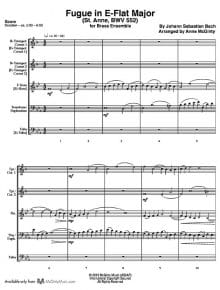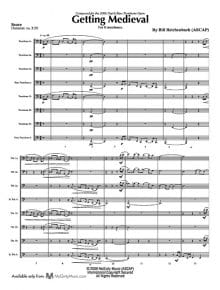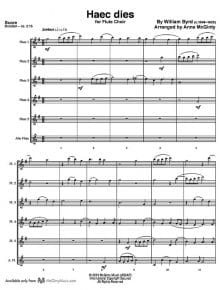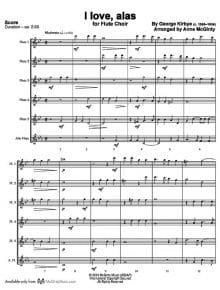Search Music
Music Categories
PDF Download Only
Purchase. Print. Play.
-
Fugue in E-Flat Major (J.S. Bach) – Large Brass Ensemble
“The triple fugue … is a symbol of the Trinity. The same theme recurs in three connected fugues, but each time with another personality. The first fugue is calm and majestic, with an absolutely uniform movement throughout; in the second the theme seems to be disguised, and is only occasionally recognisable in its true shape, as if to suggest the divine assumption of an earthly form; in the third, it is transformed into rushing semiquavers as if the Pentacostal wind were coming roaring from heaven.” ~ Albert Schweitzer
The Fugue in E-Flat Major (BWV 552) has become known in English-speaking countries as the “St. Anne” because of the first theme's resemblance to the St. Anne hymn O God, Our Help in Ages Past, a hymn that would have been unknown to Bach. A fugue in three sections of 36 bars, 45 bars and 36 bars, with each section a separate fugue on a different theme, it has been called a triple fugue, although only the first theme is combined with the second and third themes; for that reason the second and third sections are sometimes referred to as double fugues. The number three is pervasive and has been understood to represent the Trinity. The description of Albert Schweitzer follows the nineteenth century tradition of associating the three sections with the three different parts of the Trinity. The number three, however, occurs many other times: in the number of flats of the key signature; in the number of sections; and in the number of bars in each section, each a multiple of 3 x 3. Each of the three themes of the fugues seems to grow from the previous ones.
Written for organ, the ranges of each of the five fugal voices works well for the five brass instruments. Articulations and minimal dynamic suggestions have been added to honor the music, to make it sound as it would have sounded if the fugue were conceived for these modern instruments.
This fugue is available for brass quintet as well as brass ensemble. There are Eb trumpet parts included with the brass quintet version. The brass ensemble version has the traditional brass quintet parts, Eb trumpet parts, Eb horn, Euphonium TC and Eb tuba.
Composer: Anne McGinty
Instrumentation: 2 Bb and/or Eb Trumpets, F and/or EbHorn, Trombone and/or Euphonium & Tuba
Duration/# of Pages: ca. 5:30 / 38 pages, 8.5″ x 11″
Key: Eb -
Getting Medieval – Trombone Choir
This original composition for eight trombones is a very welcome addition to the literature! Written for the 2006 Dutch Bass Trombone Open, no one knows trombones like Bill Reichenbach!
There is a youtube performance of this piece at:
and
2010 Dutch Bass Trombone Open – 50 Bass Trombone players!
Composer: Bill Reichenbach
Instrumentation: 8 Trombones
Duration/# of Pages: ca. 3:55 / 24 pages, 8.5″ x 11″
Key: N/A -
Haec Dies – Flute Choir
This joyous 6-part motet is a welcome addition to the flute choir repertoire. In polyphonic and imitative style, each voice is important to the overall structure. A student of Thomas Tallis, William Byrd was the leading English composer of his time, a great master of the Renaissance along with Giovanni Palestrina and Orlando de Lassus, and left a huge legacy of printed music. The lyrics are: “This is the day the Lord has made; let us rejoice and be glad in it. Alleluia.” Each time the word rejoice appears, the melody ascends, giving added brightness and lift. The common pronunciation of “Haec” is “eck” although it may also be pronounced as “hike.” Haec dies means this is the day.
Composer: Anne McGinty
Instrumentation: 5 C Flutes & Alto Flute
Duration/# of Pages: ca. 2:15 / 13 pages, 8.5″ x 11″
Key: N/A -
I Love, Alas – Flute Choir
George Kirbye (c. 1565 – 1634) was an English composer of the late Tudor period and early Jacobean era. He was one of the members of the English Madrigal School, but also composed sacred music.
Little is known of the details of his life. He probably made the acquaintance of John Wilbye, a much more famous madrigalist, who lived and worked only a few miles away, and whose style he sometimes approaches.
Kirbye's most significant musical contributions were the psalm settings he wrote for East's psalter in 1592, the madrigals he wrote for the Triumphs of Oriana (1601), the famous collection dedicated to Elizabeth I, and an independent set of madrigals published in 1597. This piece, one of six madrigals for six voices, shows careful attention to the text setting.
The lyrics are:
I love, alas, yet am I not beloved;
My suits are all rejected,
And all my looks suspected.
Experience now too late hath proved,
That 'twas in vain that erst I loved.
This madrigal is written in an imitative style and as the different voices enter, the accompanying voices should get somewhat softer so all entrances can be easily heard. This is notated using dynamics and decrescendos at the beginning of the piece; however, the concept applies to all imitative entrances. The ranges are not extreme and this would be a good choice for young players as well as the experienced flute choir.
There is no recording available at this time.
Composer: Anne McGinty
Instrumentation: 5 C Flutes & Alto Flute
Duration/# of Pages: ca. 2:00 / 15 pages, 8.5″ x 11″
Key: N/A




